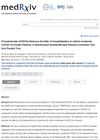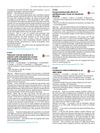Search
for
Sort by
Research
60-90 / 1000+ results
research Effect of Finasteride 5 mg (Proscar) on Acne and Alopecia in Female Patients with Normal Serum Levels of Free Testosterone
Finasteride improves acne and hair loss in women with normal testosterone.
research Efficacy of Topical Finasteride 0.5% vs 17α-Estradiol 0.05% in the Treatment of Postmenopausal Female Pattern Hair Loss: A Retrospective, Single-Blind Study of 119 Patients
Topical finasteride works faster and better than 17α-estradiol for postmenopausal hair loss.
research Patient Satisfaction and Clinical Effects of Platelet-Rich Plasma on Pattern Hair Loss in Male and Female Patients
Platelet-rich plasma is a safe and effective treatment for hair loss with high patient satisfaction.

research Management of Acne Vulgaris with Hormonal Therapies in Adult Female Patients
Hormonal therapies, like flutamide and cyproterone acetate, are safe and effective for treating adult women's acne, especially those with hormone imbalance or resistant acne.

research Proxalutamide Reduces Hospitalization Rate in Mild-to-Moderate COVID-19 Female Patients: A Randomized Double-Blinded Placebo-Controlled Trial
Proxalutamide significantly lowered hospitalization rates in women with mild-to-moderate COVID-19.

research Platelet Rich Plasma in Androgenic Alopecia in Male and Female Patients: A Myth, A Prospective Study
Platelet Rich Plasma (PRP) injections can effectively reduce hair loss and improve hair growth in both men and women suffering from androgenic alopecia.

research Comparative Study Between 2% Minoxidil Topical Spray vs. Intradermal Injection for Treatment of Androgenetic Alopecia in Female Patients: A Controlled, 4-Month Randomized Trial
Mesotherapy is more effective than topical spray for female hair loss treatment.

research Association Between Hemoglobin A1c and the Severity of Androgenetic Alopecia Among Female Patients in a Specialty Alopecia Clinic
Higher blood sugar levels may lead to more severe hair loss in women.

research Trichoscopy: Usefulness in Diagnosing Hair Loss in Adult Female Patients
Trichoscopy is a helpful and quick method to identify different types of hair loss in women.

research Risks for Metabolic Syndrome and Cardiovascular Diseases in Both Male and Female Patients with Androgenetic Alopecia
People with androgenetic alopecia, both men and women, are more likely to develop heart diseases in the future.

research Fibrosing Alopecia in a Pattern Distribution in 16 African-Descent and Hispanic Female Patients: A Challenging Diagnosis
FAPD is a possible diagnosis for hair loss in patients of color and requires multiple evaluations for accurate diagnosis.
research The Relationship of Serum Ferritin Levels in Female Patients with Telogen Effluvium: A Case Control Study
Low serum ferritin levels are linked to hair loss in women.

research Psychosocial Impact of Wigs or Hairpieces on Perceived Quality of Life in Female Patients with Alopecia Areata
Wearing wigs or hairpieces improves self-esteem, adaptability, and competence in women with alopecia areata.

research Social Status May Interfere in the Prognosis of Frontal Fibrosing Alopecia in Female Patients: An Observational Study
Higher social status is linked to earlier diagnosis and better treatment results for Frontal Fibrosing Alopecia in women.
research Assessment of the Skin Efficacy and Acceptability of a Cosmetic Product in the Treatment of Forearm Hypertrichosis in Female Patients
The cosmetic product effectively reduced hair growth and thickness on forearms.
research Correlations of the Onset of Androgenic Alopecia with Family History and Serum Dihydrotestosterone Levels in 614 Female Patients

research Experience of Novelty Laser Therapy Emission with 675 nm Wavelength for the Treatment of Androgenetic Alopecia in Male and Female Patients: A Case Series Study
The 675 nm laser treatment significantly increased hair density and reduced symptoms of androgenetic alopecia in both men and women, with no side effects.
research Evaluation of Serum Iron, Ferritin, Zinc, and Folic Acid Levels in Female Patients with Diffuse Hair Loss
Low levels of iron, ferritin, zinc, and folic acid may contribute to hair loss in women.

research Frontal Fibrosing Alopecia: A Multicenter Review of 355 Patients
Most patients with frontal fibrosing alopecia are postmenopausal women, and treatments like finasteride and dutasteride can improve or stabilize the condition.

research Prevalence of Androgenic Alopecia in Patients with Polycystic Ovary Syndrome and Characterization of Associated Clinical and Biochemical Features
Women with PCOS often have hair loss, which is linked to acne or excess body hair but not to worse hormone or metabolic issues.

research Pattern Alopecia During Hormonal Anticancer Therapy in Patients with Breast Cancer
Some breast cancer patients on hormonal therapy may develop male or female pattern hair loss, which can sometimes be improved with topical treatments.

research Polycystic Ovary Syndrome in Patients with Hair Thinning
Women with hair loss should be checked for PCOS, as it's often related and early diagnosis can help with treatment.

research Polycystic Ovarian Syndrome in Patients with Schizophrenia Treated with Atypical Antipsychotics: A Case Control Study
Women with schizophrenia on atypical antipsychotics are more likely to have polycystic ovarian syndrome (PCOS) than women without schizophrenia.

research Analysis of Familial Factors Using the Basic and Specific (BASP) Classification in Korean Patients with Androgenetic Alopecia
Familial factors affect hair loss types in Koreans, with M type in men, L type in women, and paternal factors influencing male hair loss more.

research Platelet-Rich Plasma for the Treatment of Female Pattern Hair Loss: A Patient Survey
PRP treatment satisfies 58% of female hair loss patients, with most noticing fuller, thicker hair and less shedding.

research Cutaneous Manifestations and Hormonal Changes Among Polycystic Ovary Syndrome Patients at a Tertiary Care Center
Most women with Polycystic Ovary Syndrome (PCOS) have skin issues like excessive hair, acne, or hair loss. Hormone imbalances are common, and age, certain hormones, and hormone ratios can predict acne. Obesity, infertility, and high cholesterol are also common in these women.

research Association Between Trichoscopic Features, Serum Hormone Levels, and Vitamin D Concentration in Patients With Androgenetic Alopecia in Eastern China: A Cross-Sectional Study
Higher SHBG levels are linked to less severe hair loss in women, but vitamin D levels don't seem to affect hair loss.

research Prevalence of Cutaneous Disorders in Patients with Polycystic Ovary Syndrome
All women with Polycystic Ovary Syndrome (PCOS) in a study had at least one skin disorder, with the most common being excessive hair growth, acne, dark skin patches, hair loss, and oily skin.

research Therapeutic Efficacy of Autologous Platelet-Rich Plasma and Polydeoxyribonucleotide on Female Pattern Hair Loss
PRP injections may improve hair thickness and density in female hair loss patients.